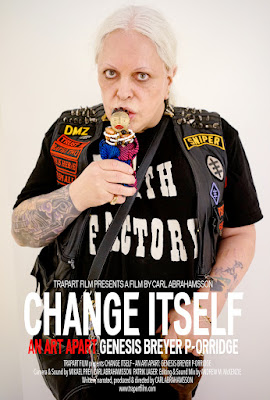Director: Carl Abrahamsson
Release Year: 2016
Release Year: 2016
Summarizing the life and work of Genesis Breyer P-Orridge is a formidable challenge. This British artist’s career spans over five decades, from the mid-1960s to the present, and unfolds across an extraordinary range of artistic disciplines. Yet what truly sets P-Orridge apart is not simply the volume or variety of creative output, but the radical nature of their vision, a persistent drive to reshape culture, identity, and consciousness itself. Carl Abrahamsson’s documentary Change Itself: An Art Apart invites viewers into this expansive universe, revealing the man who was as much a living artwork as a creator of art. Genesis Breyer P-Orridge’s journey began in Manchester in 1950. From early on, P-Orridge resisted simple categorization, rejecting the limitations imposed by traditional art forms, gender norms, and societal expectations. Their work traversed music, performance art, collage, sculpture, occult philosophy, spoken word, and more, creating a multifaceted legacy that few artists can rival.
In the late 1960s and early 1970s, P-Orridge emerged as a pivotal figure in the British underground and industrial music scenes. As a founder of seminal experimental groups such as Throbbing Gristle and later Psychic TV, they challenged the boundaries of sound and performance, combining abrasive noise with ritualistic intensity and esoteric symbolism. Their performances were not merely concerts but happenings, immersive experiences designed to disrupt complacency and provoke radical new ways of thinking. Change Itself delves deeply into these moments, using archival footage and interviews to paint a portrait of a restless creative force. It captures the confrontational spirit of Throbbing Gristle’s shows, the psychedelic mysticism of Psychic TV, and the transformative ethos that underpins everything Genesis created. These artistic endeavors were never isolated acts but interconnected components of a larger project: cultural engineering aimed at breaking down social conditioning and opening pathways to new identities and realities.
Carl Abrahamsson’s documentary frames Genesis Breyer P-Orridge as a "cultural engineer", an apt description for someone who views art not just as self-expression but as a tool for systemic change. P-Orridge’s work engages directly with societal structures, especially around gender and identity, making visible what is often hidden or suppressed. Throughout their career, P-Orridge challenged the binary constraints of gender, embracing a fluid and performative approach long before these ideas entered mainstream discourse. Alongside their partner Lady Jaye Breyer P-Orridge, Genesis developed the "Pandrogyny" project, a radical experiment in love, identity, and transformation involving extensive body modification to physically merge their identities. This project transcended art and personal life, blending the two into a living sculpture of shared identity and mutual creation. At the core of P-Orridge’s philosophy lies romantic existentialism, a passionate search for authentic existence amid the absurdity and alienation of modern life. Their work asks fundamental questions about who we are and who we can become, advocating for the continuous reinvention of the self as an act of freedom and resistance.
One of the enduring themes of Change Itself is how Genesis Breyer P-Orridge treats their work as both an artistic creation and a seed for cultural and behavioral change. This is not art for art’s sake, nor purely self-exploration. Instead, it is art with a mission, a deliberate intervention aimed at reshaping collective consciousness. P-Orridge’s extensive use of collage and cut-up techniques, drawn from avant-garde and occult traditions, illustrates this. By fragmenting and recombining images, sounds, and ideas, they disrupt conventional narratives and open space for new meanings to emerge. This method also reflects their belief in the mutability of reality and identity, reinforcing the idea that nothing is fixed and everything can be transformed. The documentary captures this ongoing process of creation and reinvention, emphasizing that P-Orridge’s work is never finished. Even in later years, despite health challenges and shifting cultural landscapes, they continued to produce, provoke, and inspire, embodying the very principle of “change itself.”
Genesis Breyer P-Orridge’s influence is immense, spanning underground music, performance art, gender theory, and beyond. They paved the way for countless artists, activists, and thinkers who challenge normative boundaries and seek to expand the possibilities of human experience. The documentary situates P-Orridge not only as a product of their time but as a visionary whose ideas remain deeply relevant. Their insistence on fluid identity, the rejection of binaries, and the embrace of transformation resonate strongly with contemporary conversations around gender and selfhood. By chronicling the breadth of P-Orridge’s work and philosophy, Change Itself offers viewers a rare glimpse into a life lived as an ongoing artwork, a testament to the power of creativity as a force for profound personal and cultural change. Summing up Genesis Breyer P-Orridge is nearly impossible, but Change Itself: An Art Apart comes closest by honoring the complexity, contradictions, and relentless energy of one of the most provocative figures in modern art.
Through the lens of Carl Abrahamsson’s documentary, we see a life dedicated to breaking down walls, between genders, between disciplines, between art and life. P-Orridge’s story is a reminder that to be human is to be in flux, to resist easy definitions, and to embrace the transformative power of change. Their legacy challenges us all to reconsider what it means to create, to love, and to exist.
via: youtube
Image credits: YouTube



.jpg)

No comments:
Post a Comment